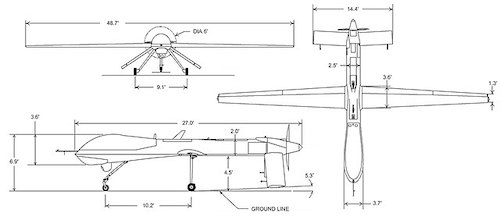MQ-1 Predator
Summary
| Category | Military Drones |
| Origin country | 🇺🇸 United States |
| Manufacturer | General Atomics |
| First flight | 3 July 1994 |
| Year introduced | 1995 |
| Number produced | 360 units |
| Average unit price | $4 million |
Description
In the early 1980s, experimental programs involving unmanned reconnaissance aircraft were initiated. By the early 1990s, interest arose in the "Amber" drone developed by Abraham Karem of Leading Systems, Inc. Following the company's bankruptcy, five of the "Amber" drones were acquired, renamed "Gnat," and Abraham Karem was contracted to develop a quieter engine for them. This new development became known as the "Predator." In January 1994, General Atomics Aeronautical Systems (GA) secured a contract to further develop the Predator. The initial Advanced Concept Technology Demonstration (ACTD) phase spanned from January 1994 to June 1996. The first flight took place on 3 July 1994, at El Mirage airfield in the Mojave Desert, utilizing an aircraft derived from the GA Gnat 750. During the ACTD phase, three systems, each comprising twelve aircraft and three ground control stations, were purchased from GA. These systems were deployed to Gjader, Albania, in the spring of 1995 for operations in the former Yugoslavia. The Predator system was initially designated the RQ-1, with pre-production and production models named RQ-1A and RQ-1B, respectively. In 2002, the designation was officially changed to MQ-1, reflecting its expanded role as an armed aircraft.
The MQ-1 Predator, designated as a "Tier II" MALE UAS (medium-altitude, long-endurance unmanned aircraft system), integrates four air vehicles equipped with sensors, a ground control station (GCS), and a primary satellite link communication suite. Power is provided by a Rotax engine driving a propeller, enabling the aircraft to operate at a range of up to 400 nmi (460 mi; 740 km) from its base. The Predator is designed for long-endurance loitering, capable of remaining airborne for 14 hours over a target area before returning.
Later versions such as the MQ-1B included an ARC-210 radio, an APX-100 IFF/SIF with mode 4, a glycol-weeping "wet wings" de-icing system, an upgraded turbo-charged engine, fuel injection, longer wings, and dual alternators. The aircraft is equipped with the AN/AAS-52 Multi-spectral Targeting System, a color nose camera for pilot control, a variable aperture day-TV camera, and a thermographic camera for low light/night operations, providing real-time surveillance capabilities. Later models incorporated a laser designator for target identification and laser guidance for other aircraft and its own AGM-114 Hellfire missiles.
The MQ-1 Predator features hardpoints capable of carrying various combinations of ordnance. The MQ-1B variant can carry two AGM-114 Hellfire air-to-surface missiles or up to four Air-to-Air Stinger (ATAS) missiles. Furthermore, it has been modified to carry six AGM-176 Griffin air-to-surface missiles. Early airframes of the MQ-1A Predator were also equipped with this ordnance carrying capability, though these models lacked the AN/ZPQ-1 synthetic-aperture radar found in earlier reconnaissance versions.
The MQ-1 Predator has been deployed in various theaters. Its initial deployment was in the Balkans in 1995 for intelligence collection missions. The Predator saw extensive use in Afghanistan following 2001, providing reconnaissance and engaging targets with Hellfire missiles after being armed. It was used in Pakistan, operating from Shamsi airfield to target militants, including one strike that resulted in civilian casualties. In Iraq, a Predator was shot down by an Iraqi MiG-25 in 2002. Later in Iraq, Predators were used as decoys and for close air support, experiencing vulnerabilities such as unencrypted video feeds. The MQ-1 participated in targeted killings in Yemen. During Operation Unified Protector in Libya, it performed reconnaissance and strike missions, and also saw action in Somalia against al-Shabaab. By 2009, the USAF operated 195 MQ-1s. The USAF retired the Predator in 2018, while derivatives such as the MQ-1C Gray Eagle continued to serve with the U.S. Army and other nations. Italy also operated the Predator A in Iraq, Afghanistan, and Djibouti.
Main Variants:
-
RQ-1A: This was the pre-production designation for the initial Predator system, comprising four aircraft, a Ground Control Station (GCS), and a Predator Primary Satellite Link (PPSL).
-
RQ-1B: This designation marked the baseline production configuration of the Predator UAV system, succeeding the pre-production RQ-1A.
-
MQ-1A Predator: These early airframes were modified to carry ordnance, specifically the AGM-114 Hellfire ATGM or AIM-92 Stinger missiles, and had the nose-mounted AN/ZPQ-1 Synthetic Aperture Radar removed.
-
MQ-1B Predator: These later airframes were also capable of carrying ordnance, and featured a modified antenna fit, including a spine-mounted VHF fin, as well as enlarged dorsal and ventral air intakes for the Rotax engine.
-
Predator XP: This export variant was specifically designed to be unable to carry weapons, allowing for broader export opportunities, and it featured winglets with a long endurance and service ceiling.
Technical specifications
| Version: MQ-1A Predator | |
|---|---|
| Operational range | 740 km (460 mi) |
| Endurance | 24 hours |
| Maximum speed | 217 km/h (135 mph) |
| Wingspan | 14.8 m (48.6 ft) |
| Length | 8.2 m (27.0 ft) |
| Service ceiling | 7,620 m (25,000 ft) |
| Empty weight | 512 kg (1,129 lbs) |
| Max. takeoff weight | 1,020 kg (2,249 lbs) |
| Powerplant | 1 x Rotax 912ULS delivering None each |
All operators
